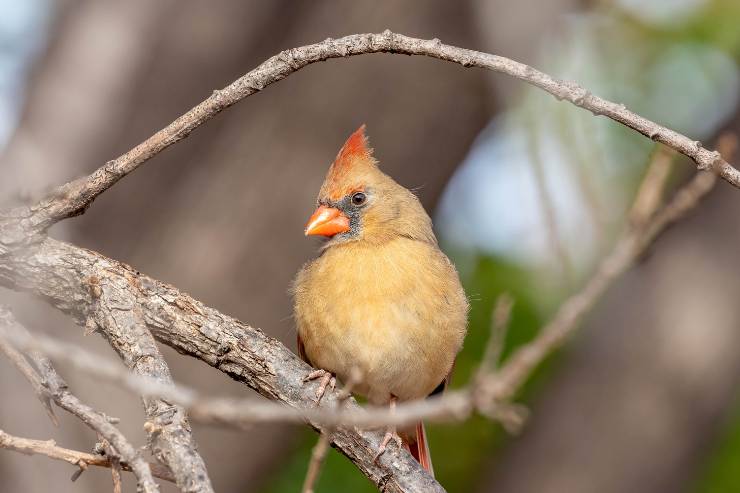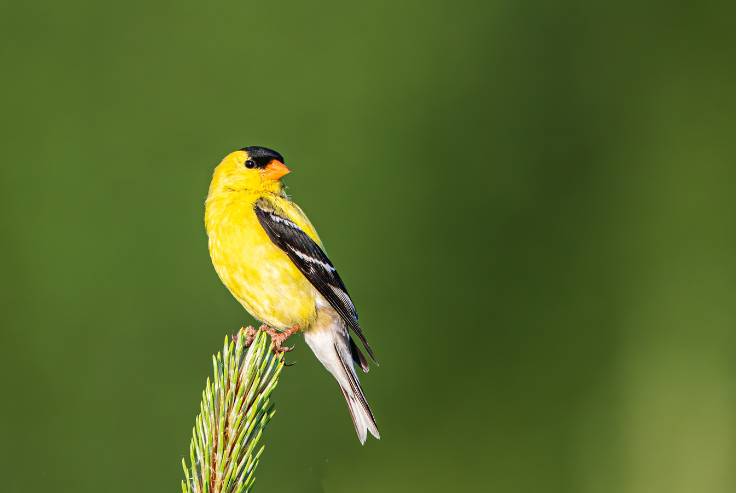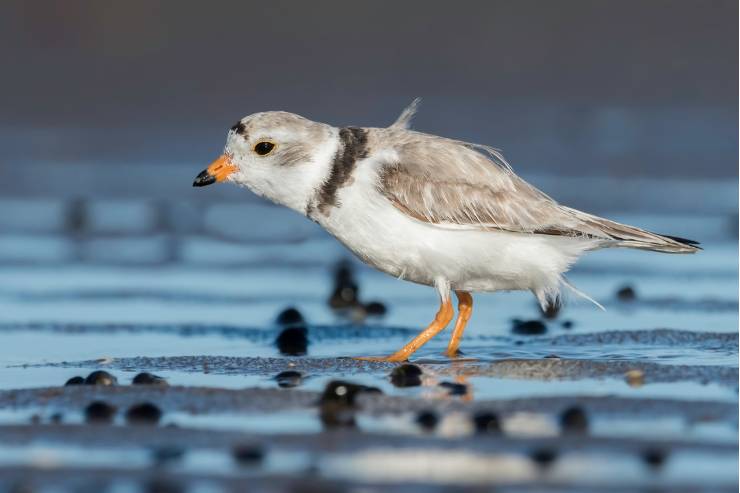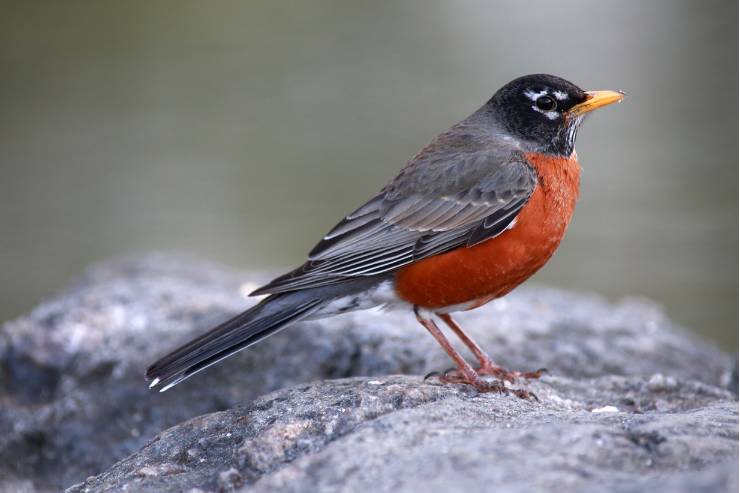4 Brown birds with orange beak

There are many different kinds of brown birds with orange beaks, each having their own traits and home ranges.
These birds, distinguished by their orange beaks and brown plumage, can be found in various global habitats, including broad grasslands, deep woods, and cities.
Their coloring helps them to blend in with their environment and attract potential partners during mating seasons. Many of these birds are essential to pollination, seed dissemination, and insect control in their particular environments, even if the specific species differ.
The American robin, Northern cardinal, and American goldfinch are a few well-known species of brown birds with orange beaks.
These birds have unique behaviors and adaptations that make them essential to the natural world. So, without any delay, let’s learn about these birds in detail.
List of Four Brown Birds with Orange Beaks:
- Northern Cardinal (Female)
- American Goldfinch
- Piping Plover
- American Robin
1. Northern Cardinal (Female)
The medium-sized perching bird known as its unique appearance easily recognizes the northern cardinal.
The general color of female northern cardinals is pale brown, with warm reddish tones showing in the wings, tail, and crest. They have a black face and a red-orange beak like their male counterparts.
The average lifespan of a northern cardinal is at least three years, while some have been known to live up to fifteen.

The conservation status of this species is categorized as least concern. Although female northern cardinals are uncommon among
North American songbirds are known to sing frequently when perched on the nest.
Size, wingspan, weight, beak size, and conservation status of Northern cardinals:
- Scientific name: Cardinalis Cardinalis
- Size: 21 to 23.5 centimeters (8.3 to 9.3 inches)
- Beak size: Not known
- Wingspan: 25 to 31 centimeters (9.8 to 12.2 inches)
- Weight: 33.6 to 65 grams (1.19 to 2.29 oz)
- Life span: Three years
- Conservation status: Least concern
Habitat: In addition to living in parks, residential areas, thickets, and woodlands, northern cardinals also spend the winter in open fields.
Feeding: Northern cardinals’ primary food sources include fruits, cereals, sunflowers, and weed seeds. They have developed powerful, broad beaks that allow them to crack open seeds easily, especially those with easily detachable husks. You can attract northern cardinal by providing above foods.
Although much of their food consists of seeds, they eat insects, mainly when feeding their young.
2. American Goldfinch
America. It migrates throughout specific seasons. Male adults have bright yellow plumage with a black forehead and wings.
It has White markings and white patches above and below the tail in the spring and early summer. Adult females, on the other hand, have olive-colored upperparts and a duller yellow underside.

Their appearance is more muted in winter, with two pale wing bars, brown plumage without streaks, and wings that resemble black.
These birds usually live three to six years in the wild. Although protected by the Migratory Bird Act, American goldfinch populations are considered steady, and the American goldfinch is the least concerned.
Size, wingspan, weight, beak size and conservation status of American Goldfinch:
- Scientific name: Spinus tristis
- Size: 11 to 14 centimeters (4.3 to 5.5 inches)
- Beak size: Not known
- Wingspan: 19 to 22 centimeters (7.5 to 8.7 inches)
- Weight: 11 to 20 grams (0.39 to 0.71 oz)
- Life span: 3 to 6 years
- Conservation status: Least concern
Habitat: Except for areas with deep forests, the American goldfinch is found throughout North America. It usually lives on the edges of plains and woodlands, preferring regions with thistle and brush vegetation.
Feeding: Its primary food source is seeds, especially those from the daisy (composite) family, but it also eats the seeds from grasses, weeds, and small trees such as alder, birch, and elm.
American goldfinch also eats maple sap, buds, and the bark of young twigs.
During the summer, this species, primarily consisting of seeds, serves as the primary food source for young birds. However, insects do play a role in their diet.
3. Piping Plover
The Piping Plover is a small shorebird with a sparrow-like appearance. Its greatest features are its year-round yellowish-orange legs and sandy-colored plumage with white undersides.
It has an orange bill with a black tip during the mating season and a black collar and foreheadline that turn grey outside during breeding seasons.
The average lifespan of Piping Plovers is expected to be five to six years, with a noteworthy adult survival rate of 78 to 80%. However, some have been observed to live up to 11 years.

Even with recent population increases, the species is still protected by the Endangered Species Act; American goldfinch is listed as Threatened elsewhere in the United States and as Endangered in the Great Lakes region.
Size, wingspan, weight, beak size and conservation status of Piping Plover:
- Scientific name: Charadrius Melodus
- Size: 17 centimeters (7 inches)
- Beak size: Not known
- Wingspan: 38 centimeters (15 inches)
- Weight: 40 to 65 grams (1.4 to 2.3 oz)
- Life Span: 5 to 6 years
- Conservation Status: Near threatened
Habitat: Piping Plovers live in various habitats and adjust their movements to the tides and climate in the area.
They prefer sandy beaches with little vegetation that provide access to mudflats and tidal creeks for feeding.
Piping Plovers are found in coastal locations such as shoals, tidal flats, small islands, and sand spits.
Feeding: Their main food source is small aquatic invertebrates such as mollusks, crabs, beetles, marine worms, and fly larvae.
4. American Robin
The migratory American robin, a member of the Turdidae family of thrush birds, is distinguished by its gray-brown plumage with bright orange underparts and dark heads.
When flying, a noticeable white patch on the lower belly and under the tail is visible.
In general, the heads of female robins are lighter than those of males, which means that their gray backs contrast less with them.

Their throats are white with black lines; the male neck is darker than the female’s. Their slender beaks are yellow-orange with a gray tip. American robin life span is 14 years.
The American robin has an extensive population that is increasing, and it is the least concern species.
Size, wingspan, weight, beak size and conservation status of American Robin:
- Scientific name: Turdus Migratorius
- Size: 23 to 28 centimeters (9.1 to 11.0 inches)
- Beak size: Not known
- Wingspan: 31 to 41 centimeters (12 to 16 inches)
- Weight of male: 72 to 94 grams (2.5 to 3.3 oz)
- Weight of female: 59 to 91 grams (2.1 to 3.2 oz)
- Life Span: 14 years
- Conservation Status: Least concern
Habitat: American robins live in various habitats, such as parks, meadows with shrubs, suburban areas, and woodlands.
While some move north to Alaska for the summer, they are year-round residents of the continental United States
Feeding: Their primary food sources include earthworms, berries, and insects. In the early summer, American robin eat insects, and other invertebrates, like spiders and snails, are mainly consumed.
They also eat a lot of fruit, especially in the winter, with some cultivated fruits added to the primary source of wild berries.
Conclusion
In conclusion, the vast array of brown birds with orange beaks spans various ecosystems globally, from hectic cities to peaceful woodlands.
They are easily recognized by their unique plumage, which combines bright orange beaks with brown tones.
These bird species, which include the American robin, American goldfinch, Piping Plover, and Northern cardinal, each have distinctive characteristics and adaptations that help them survive and play an essential part in the environment.
These birds, whether migrating or scavenging for seeds and insects, are vital to the health and balance of their ecosystems because they help with pollination, seed distribution, and insect control.






